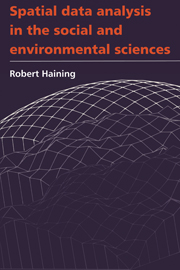Book contents
- Frontmatter
- Contents
- List of tables and displays
- Preface
- Acknowledgements
- PART A Introduction to issues in the analysis of spatially referenced data
- PART B Parametric models for spatial variation
- PART C Spatial data collection and preliminary analysis
- PART D Modelling spatial data
- 7 Analysing univariate data sets
- 8 Analysing multivariate data sets
- Postscript
- Glossary
- References
- Index
7 - Analysing univariate data sets
Published online by Cambridge University Press: 05 August 2012
- Frontmatter
- Contents
- List of tables and displays
- Preface
- Acknowledgements
- PART A Introduction to issues in the analysis of spatially referenced data
- PART B Parametric models for spatial variation
- PART C Spatial data collection and preliminary analysis
- PART D Modelling spatial data
- 7 Analysing univariate data sets
- 8 Analysing multivariate data sets
- Postscript
- Glossary
- References
- Index
Summary
Section 7.1 considers the problem of finding a good description of a spatial surface. We begin by considering how to fit a trend surface model in which spatial variation is assumed to contain three scale components: a large scale or regional trend, a local component of continuous (spatially correlated) variation and a site or area level random (or noise) component. Comparisons with geostatistical approaches are made. Models for non-normal and presence/absence data are briefly considered. Good description of spatial variation is important for summarising data and for interpolation. If data are available on the same variable in other areas it may be of interest to compare surfaces. If data are available on the same variable in the same area but over a succession of time periods comparative study might be concerned with identifying how the surface is changing through time and to relate this to changes in conditions. Over a relatively short span of time this might take the form of a ‘before and after’ study, such as monitoring and assessing the effects of an anti-pollution campaign.
In section 7.2 spatial interpolation problems are discussed. Observations on a continuous surface are made at a number (n) of point sites in an area. These might be soil or vegetation measurements, or data from geological samples. Estimates may be required for sites that have not been visited (together with error estimates); perhaps a map is required.
- Type
- Chapter
- Information
- Spatial Data Analysis in the Social and Environmental Sciences , pp. 249 - 312Publisher: Cambridge University PressPrint publication year: 1990

